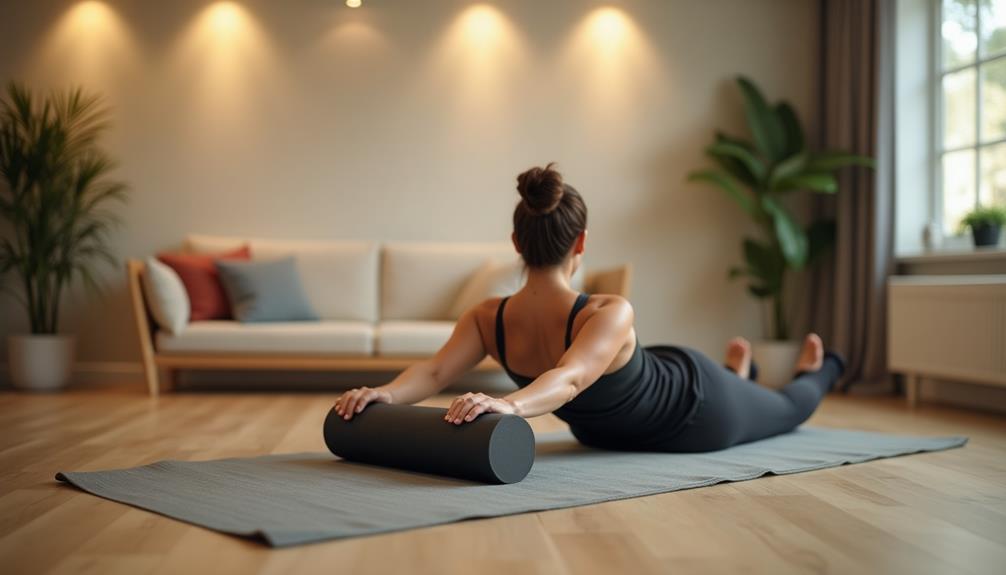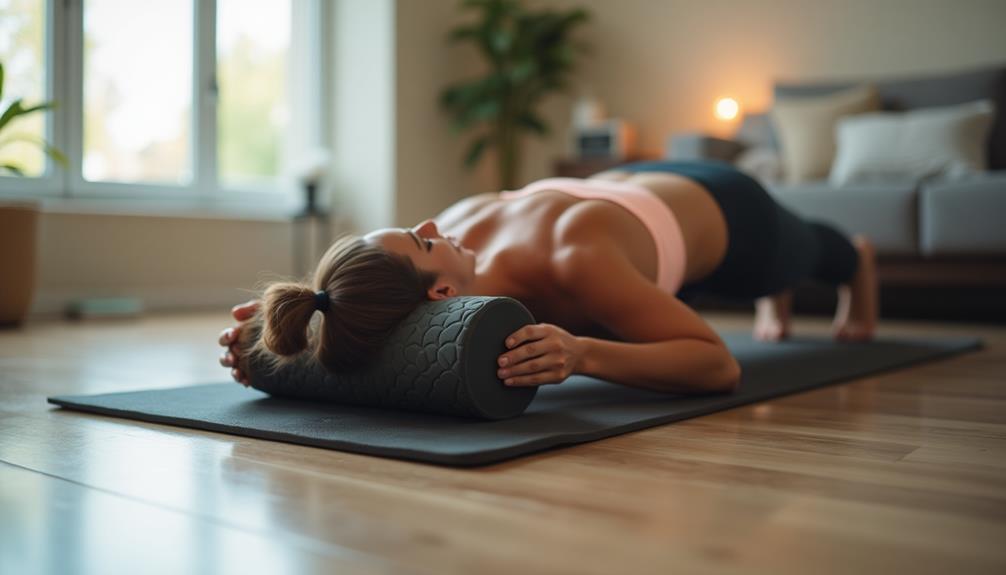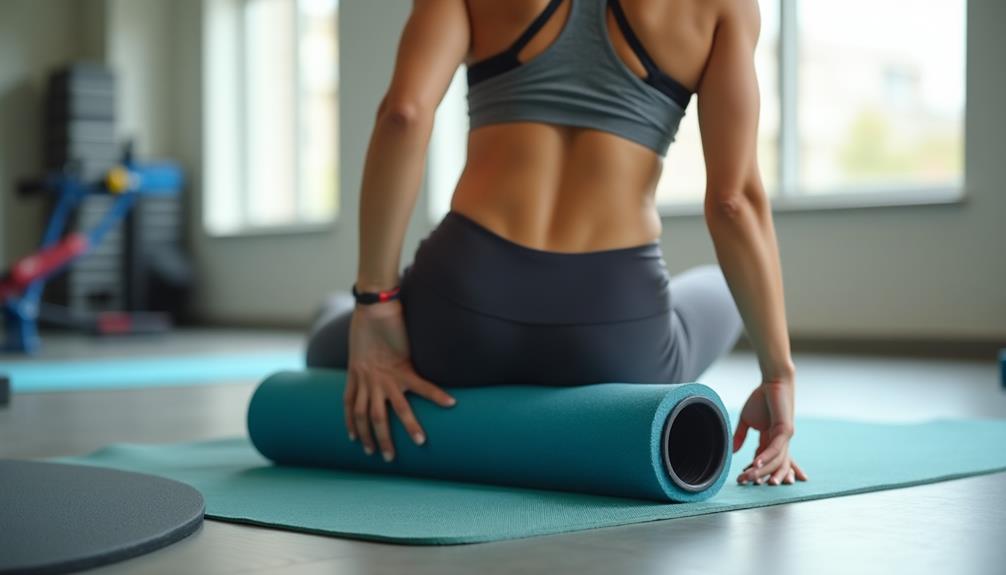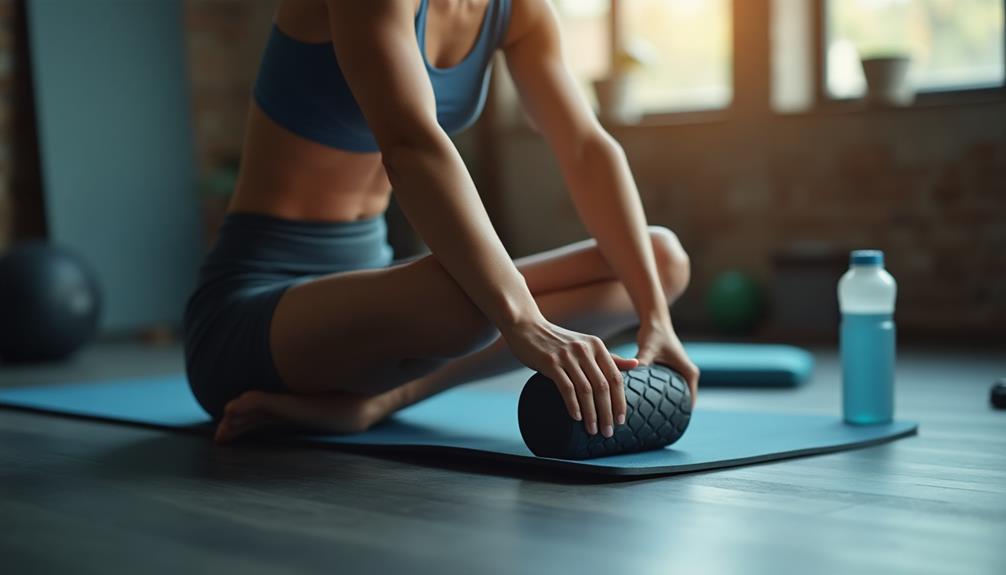Mastering foam rolling is essential for your post-workout recovery. It helps reduce muscle soreness, improves flexibility, and enhances circulation. To get started, choose the appropriate foam roller for your needs. Begin with slow, controlled movements, and focus on your breathing. Target key areas like your glutes, back, and legs. Avoid common pitfalls, such as rolling too quickly or ignoring pain signals. Remember to hydrate and adjust pressure using your body weight. With the right tools and techniques, you can maximize your recovery and improve performance. Stick around to explore more tips on effective foam rolling practices.
Core Insights
- Foam rolling reduces muscle soreness and enhances recovery by improving circulation and releasing built-up tension in targeted areas.
- Use slow, controlled movements while foam rolling to effectively target major muscle groups and enhance flexibility.
- Focus on areas like the glutes, upper and lower back, and other muscle groups for optimal recovery benefits.
- Avoid common mistakes by paying attention to pain signals, hydrating, and applying consistent pressure throughout your routine.
- Incorporate foam rolling into your post-workout routine or warm-up to maximize performance and prevent injuries.
What Is Foam Rolling?

Foam rolling is a popular self-myofascial release technique that helps improve muscle recovery and flexibility. It involves using a foam roller, a cylindrical piece of equipment, to apply pressure to various muscle groups. By rolling over the foam, you can release tension in your muscles and fascia, the connective tissue surrounding them. Dense foam rollers offer firm compression for deep tissue massage and are often recommended by physical therapists for best results. These rollers can support muscle recovery, improve circulation, and aid in myofascial release.
This technique is beneficial for athletes and fitness enthusiasts alike. It's simple to learn and can easily be incorporated into your routine. You can perform foam rolling on your own at home or in the gym. Just find a comfortable spot, target the areas that feel tight, and roll slowly. With practice, you'll discover how effective foam rolling can be for maintaining your body's overall health and performance.
Benefits of Foam Rolling

After a tough workout, you might be surprised by the numerous benefits foam rolling can offer. It's not just about relieving soreness; it enhances your overall recovery. Here's a quick look at some key benefits:
| Benefit | Explanation |
|---|---|
| Reduces Muscle Soreness | Helps alleviate post-exercise discomfort. |
| Increases Flexibility | Promotes better range of motion in your muscles. |
| Improves Circulation | Enhances blood flow, aiding in recovery. |
| Enhances Performance | Preps your muscles for future workouts. |
| Prevents Injuries | Helps identify tight spots to avoid strain. |
Incorporating foam rolling into your routine can make a significant difference in how your body feels and performs after exercise. Give it a try!
Essential Foam Rolling Techniques

Incorporating foam rolling into your post-workout routine is a game changer, but knowing the right techniques is key to maximizing its benefits. Start by choosing the right foam roller; a firm one provides more pressure, while a softer option is gentler. For deep tissue work, consider a high-density foam roller with textured surfaces to target specific areas more effectively.
Begin with slow, controlled movements. Roll over each muscle group for about 30 seconds, pausing on tight spots to release tension.
Focus on your breathing; inhaling deeply helps you relax, making the process more effective.
Use your body weight to adjust pressure—shift your position to target sore areas more effectively.
Target Areas for Foam Rolling

Don't forget your glutes; they play a crucial role in mobility. Apply pressure on these muscles to alleviate soreness. Textured surfaces on foam rollers can provide enhanced blood flow and targeted pressure for muscle knot relief. Using a high-density foam roller can offer deeper compression for more effective relief. Finally, target your back, especially the upper and lower regions. Foam rolling can help release built-up tension and improve circulation. By focusing on these areas, you'll promote better recovery and prepare your body for the next workout. Remember, consistency is key for effective results.
Common Mistakes to Avoid

Many people underestimate the importance of proper technique when foam rolling, which can lead to ineffective recovery or even injury. To maximize your foam rolling benefits, avoid these common mistakes:
- Rolling Too Fast: Don't rush through the process. Slow, controlled movements help identify tight spots and allow for better muscle release.
- Ignoring Pain Signals: While some discomfort is normal, sharp pain isn't. If you experience this, stop and reassess your technique or the area you're targeting.
- Not Hydrating: Hydration is key for muscle recovery. Make sure you drink enough water before and after your foam rolling session to help flush out toxins.
Incorporating Foam Rolling Into Routine

To reap the full benefits of foam rolling, incorporating it into your workout routine consistently is vital. Start by setting aside a few minutes after each workout for foam rolling. This practice helps relieve muscle tension and enhances recovery.
You can focus on major muscle groups, like your quads, hamstrings, and back. Aim for 1-2 minutes per area, using controlled movements.
Consider adding foam rolling into your warm-up as well. It can improve blood flow and prepare your muscles for activity.
Remember to listen to your body; if you find a particularly tight spot, spend extra time there. By making foam rolling a regular part of your routine, you'll enhance your overall performance and recovery.
Tools for Effective Foam Rolling

- Foam Roller: A dense foam roller helps release muscle tightness and enhance blood flow. Look for one with a textured surface for deeper pressure.
- Massage Ball: A massage ball targets smaller muscle areas, like your feet and shoulders. It's perfect for pinpointing knots and tight spots.
- Lacrosse Ball: This hard ball is excellent for applying concentrated pressure to trigger points, offering deep tissue relief where you need it most.
Choosing the right tools allows you to customize your foam rolling experience, enhancing your post-workout recovery noticeably.
Frequently Asked Questions
How Often Should I Foam Roll for Optimal Recovery?
To optimize recovery, you should foam roll at least two to three times a week. After intense workouts, rolling every day can help relieve soreness and improve flexibility, making it a key part of your routine.
Can Foam Rolling Help With Injury Prevention?
Foam rolling can definitely help with injury prevention. By increasing blood flow and flexibility, you reduce muscle tension and improve recovery. Regularly incorporating it into your routine keeps your muscles healthy and ready for action.
Is Foam Rolling Safe for Beginners?
Yes, foam rolling's safe for beginners. Just start slowly, focusing on tight areas, and listen to your body. You'll ease muscle tension and improve flexibility without risking injury. Enjoy the process and stay consistent!
Should I Foam Roll Before or After Workouts?
Foam rolling before a workout's like warming up a car on a chilly morning; it gets your muscles ready. After workouts, it helps ease soreness and promotes recovery. So, roll before and after for best results!
How Long Should Each Foam Rolling Session Last?
Each foam rolling session should last about 10 to 15 minutes. Focus on major muscle groups, spending 30 seconds to 1 minute on each area. This'll help release tension and improve overall flexibility and recovery.

